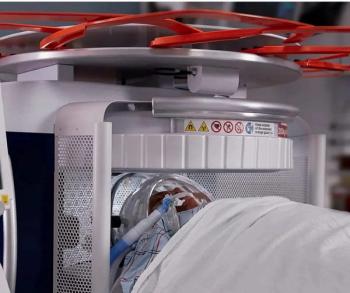
Diffusion-weighted imaging boosts MR depiction of peritoneal metastases
Diffusion-weighted imaging can help radiologists significantly improve the accuracy of conventional MR imaging of peritoneal metastases.
Diffusion-weighted imaging can help radiologists significantly improve the accuracy of conventional MR imaging of peritoneal metastases.
Dr. Russell N. Low, medical director of Sharp and Children's MRI Center in San Diego, conducted a study of 24 oncology patients who underwent preoperative abdominal MRI to affirm his suspicions about the diagnostic benefit of adding DWI to the protocol. His results were presented at the joint meeting of the International Society for Magnetic Resonance in Medicine and the European Society for Magnetic Resonance in Medicine and Biology in May.
Seventeen women and seven men were recruited. Their average age was 58.5 years. Primary tumors in the patients included seven cases of ovarian cancer, eight pseudomyxoma peritonei, four colon cancers, and one case each of pancreatic, breast, urachal, and gastrointestinal stromal cancers.
The abdominal and pelvic MRI performed on a 1.5T scanner involved breath-hold single-shot spin-echo echo planar imaging with b-values of 300 to 500 sec/mm and slice thicknesses of 7 to 8 mm. Single-shot RARE coronal images and axial T1 gradient-echo and fat-suppressed T2-weighted images covered the abdomen and pelvis as well. Following an injection of gadolinium contrast, dynamic fat-suppressed enhanced 3D gradient-echo and delayed fat-suppressed 2D GE MRI were performed, along with delayed coronal and sagittal 3D gradient-echo imaging.
A site-by-site comparison of DWI, MRI, and combined DWI/MRI results with the surgical and histopathologic evaluations underscored the advantage of using DWI and MRI together. Based on 153 sites of confirmed peritoneal tumor, DWI/MRI identified 141 sites with 14 false positives. Its sensitivity, specificity, and accuracy were 92%, 92%, and 93%, respectively. MRI alone was 78% sensitive, 86% specific, and 82% accurate. The performance of DWI alone for the three parameters was 75%, 87%, and 81%.
Working with Dr. Robert Barone, director of surgical oncology at Sharp Healthcare, Low found the addition of DWI increased confidence for image interpretation in 75% of the cases. It uncovered relevant additional diagnostic information in 63%.
Peritoneal tumor demonstrated restricted diffusion with high signal intensity on DWI, Low said. Ascitic fluid was low signal intensity on DWI, which helped increase the conspicuity of peritoneal tumors.
The addition of DWI to conventional MRI was particularly effective for depicting additional mesenteric and bowel serosal tumor. It revealed additional mesenteric tumor in three patients, small-bowel serosal tumor in four patients, and serosal colonic tumor in four patients. DWI also showed uterine serosal implants in four patients that were not depicted on conventional MRI.
For more information from the Diagnostic Imaging archives:
Newsletter
Stay at the forefront of radiology with the Diagnostic Imaging newsletter, delivering the latest news, clinical insights, and imaging advancements for today’s radiologists.

























